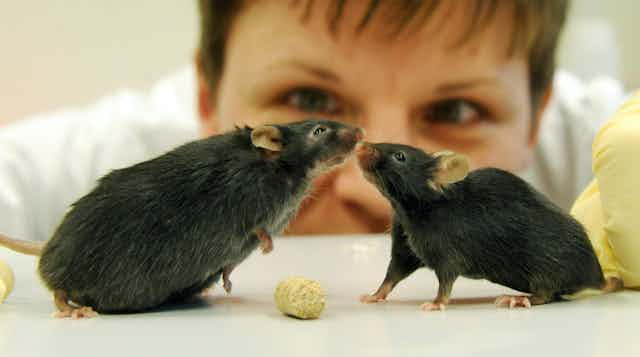Every year, millions of animals are used in scientific research across the UK. Statistics suggest that almost four million scientific procedures were carried out on animals in 2016 alone. The majority of these were reported to be on mice (73%), followed by fish (14%), rats (6%) and birds (4%). The remaining proportion was made up of other species including horses and other equines (0.23%), dogs (0.13%), primates (0.09%) and cats (0.004%).
These numbers make most of us feel a little uneasy. While many understand and accept (perhaps reluctantly) that animal research is necessary for tackling the major health, environmental and economic issues of our times, the fact that so many animals are used for advancing these causes can seem counter-progressive and cruel.
Still, we cannot shy away from the reality that this research is going on and is of huge benefit to human beings and other species. So it is important to consider the facts.
The animals
Closer examination of these numbers reveals several things. First, they only include non-human vertebrates – animals with a backbone – and cephalopods, such as octopus or squid. These animals are deemed capable of experiencing pain, suffering, distress and lasting harm. As a result they are covered by the Animals (Scientific Procedures) Act (ASPA), the UK legislation for regulation of animal research.
However, trillions of invertebrates – animals without a backbone such as insects, worms, crustaceans and molluscs – are used each year for research into a range of topics including genetics, health and food security. Historically, invertebrate species have been thought to have less developed sensory systems and considered less likely to experience pain; for this reason they are not covered by ASPA legislation.
As our understanding of the physiology and behaviour of these “less feeling” creatures improves, this seemingly arbitrary division of protection for backboned vs non-backboned (with the exception of cephalopods) has started to blur. Recent evidence suggests that some invertebrates may well have capacity for feeling pain and distress, so there may be an argument for ASPA inclusion.
The procedures
The majority of ASPA-covered research animals are used in genetic research. In 2016, for example, approximately 50% of all animals (mostly mice) were used for the creation of genetically altered animals.
A large proportion of these creatures – 37% in 2016 – were also used in basic research into improvements in the health and safeguarding of various species, and applied research such as the development of antibiotics and vaccines.

A contentious area is “regulatory testing” which covers animal use for testing of chemicals to determine hazards to humans. It should be noted that this does not include cosmetic testing, banned in the UK since 1998. While a relatively smaller percentage (approximately 14% in 2016) in comparison to other uses, this remains a miserable fate for several hundred thousand animals.
Though uncomfortable to discuss, the severity of procedures is also worth considering. Referring to the level of discomfort, pain and suffering that an animal will experience, it is categorised in order of increasing severity: below-threshold; mild; moderate; severe; and non-recovery (death). In 2014, approximately 6% of procedures to ASPA-regulated animals were deemed severe.
The researchers
The uneasiness felt by much of the public around the use of animals for research extends into the research community. Many researchers feel strongly conflicted about using animals to support their research, especially those whose aim is to ultimately preserve and protect animals.
This ethical dilemma can motivate a researcher to ensure that research is carried out in a highly humane and responsible manner. It may also assure a strong rationale and high degree of experimental rigour so that results are meaningful and valid.
Maintaining the welfare of animals is also of considerable benefit to researchers. For example, where animals are sick or in discomfort, results will be highly flawed. Animal research can be a costly business, so lack of provision of humane conditions can also lead to major financial losses. Finally, there are major legal implications to consider. Anyone not adhering to regulations can face penalties ranging from the loss of research licenses to imprisonment.
The ASPA regulating office (that is, the UK Home Office) and the research community do not take the use of animals lightly, and there are substantial conditions that must be met. First, all research on ASPA-regulated animals cannot be conducted without Home Office licensing of the relevant institute, research project and researcher.
The Home Office also requires that organisations carrying out animal research have a comprehensive and dedicated team of individuals (including their own vet) which oversees all procedures and research personnel. All institutes conducting animal research should also have an Animal Welfare and Ethical Review Body (AWERB) that provides guidance on all aspects of animal well-being. An AWERB also provides ethical review of all research projects and protocols which involve any animals (including invertebrates) in any way.

The use of animals in research is by no means ideal and the promotion of ways to reduce this kind of research is well underway. The 3R principles – replacement, reduction and refinement – provide a framework for animal research by which all researchers and their institutions must demonstrate progression. The 3Rs call for animals to be (i) replaced with alternatives such as models or in vitro approaches (for example, testing takes place on cells which are grown externally rather than using the whole organism); (ii) reduced in numbers (where enough animals are used to ensure statistically significant results but not in excess); and (iii) for experimental procedures to be refined to avoid unnecessary suffering.
In terms of society, it is vital that we are not indifferent about the use of animals in research. Instead, we should each aim for a comprehensive understanding and appreciation of the immense sacrifice that animals provide for the benefit of other life on this planet. We owe them that.

